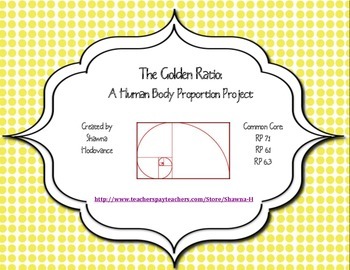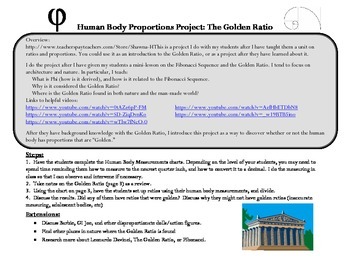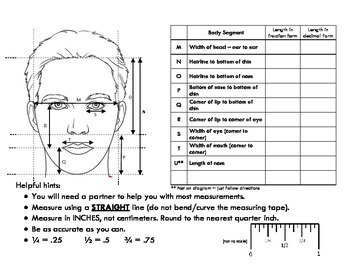Golden Ratio: A Human Body Proportions Project (Ratios and Proportions) PHI
Shawna - Making Math Meaningful
1.9k Followers
Grade Levels
6th - 12th, Adult Education, Homeschool
Subjects
Resource Type
Standards
CCSS7.G.A.1
CCSS6.RP.A.1
CCSS7.RP.A.2
Formats Included
- PDF
Pages
6 pages
Shawna - Making Math Meaningful
1.9k Followers
What educators are saying
I really appreciate this resource. It was exactly what I needed to compliment my unit. My students did well with the comprehensive activities.
Description
My students loved this project. After a unit on ratios and proportions, I did a mini-lesson on the Fibonacci Sequence and the Golden Ratio. This projects asks the kids to discover whether or not any of their body measurement ratios match the Golden Ratio. I saw lessons similar to this on the internet, but this includes diagrams, tables, and notes that help scaffold the lesson for the students.
The students loved getting out of their seats and doing all the measurements, and were surprised to see all of the proportions that exist in the human body.
There are many extensions you can do after this lesson: Fibonacci Sequence, Leonardo Da Vinci, Mondrian, Statue of Liberty, etc.
Here are some other products from my store that relate to ratios and proportions:
Best Seller!: Unit Rate Maze
Unit Prices Maze: Which Product is the Better Buy?
Scaffolded Notes on Ratios, Unit Rates, and Unit Prices
Unit Rate, Unit Price, and Ratio Tables Practice Problems
A FREE review of basic ratio/proportion concepts
Solving Proportions with Cross Products (with differentiated levels of problems)
Solving Word Problems with Proportions
The students loved getting out of their seats and doing all the measurements, and were surprised to see all of the proportions that exist in the human body.
There are many extensions you can do after this lesson: Fibonacci Sequence, Leonardo Da Vinci, Mondrian, Statue of Liberty, etc.
Here are some other products from my store that relate to ratios and proportions:
Best Seller!: Unit Rate Maze
Unit Prices Maze: Which Product is the Better Buy?
Scaffolded Notes on Ratios, Unit Rates, and Unit Prices
Unit Rate, Unit Price, and Ratio Tables Practice Problems
A FREE review of basic ratio/proportion concepts
Solving Proportions with Cross Products (with differentiated levels of problems)
Solving Word Problems with Proportions
Total Pages
6 pages
Answer Key
N/A
Teaching Duration
2 days
Report this resource to TPT
Reported resources will be reviewed by our team. Report this resource to let us know if this resource violates TPT’s content guidelines.
Standards
to see state-specific standards (only available in the US).
CCSS7.G.A.1
Solve problems involving scale drawings of geometric figures, including computing actual lengths and areas from a scale drawing and reproducing a scale drawing at a different scale.
CCSS6.RP.A.1
Understand the concept of a ratio and use ratio language to describe a ratio relationship between two quantities. For example, “The ratio of wings to beaks in the bird house at the zoo was 2:1, because for every 2 wings there was 1 beak.” “For every vote candidate A received, candidate C received nearly three votes.”
CCSS7.RP.A.2
Recognize and represent proportional relationships between quantities.





